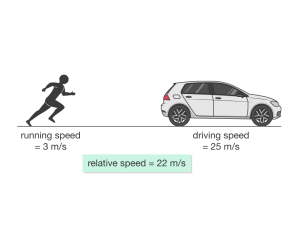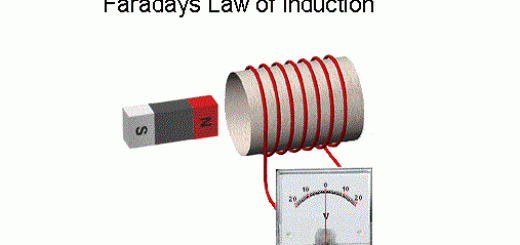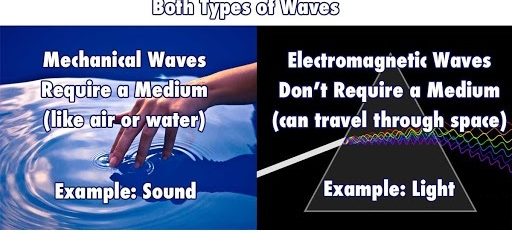Motion in one direction, Types of Speed, Average Speed and Relative Speed
Motion happens all around us. Every day, we see objects such as cars and motorbikes move in different directions at different speeds. When the position of an object (as a bike) changes as time passes according to the position of another fixed object (as a traffic light), we can say that the first object (the bike) is in a state of motion.
Motion
Motion is the change of an object position (location) as time passes according to the position of another fixed object, The simplest type of motion is the motion in a straight line in one direction, such as the motion of the train or the Metro. The motion of a train (or metro) is considered an example of motion in one direction because the train (or metro) moves forward or backward in a straight path or curved path or a combination of both.
Speed
You can describe the motion of some objects around you as fast and some others as slow, Speed is a physical quantity that is used to describe and compare the motion of objects, If there are two cars, one of them is Red and the other is Blue, which of them is faster in the following two cases?
The first case: If the two cars move for the same period of time which is 5 sec. The red car covers a distance of 100.m, the Blue car covers a distance of 50 m, we find that the Red car is faster than the Blue car because it covers a large distance (100 m.) at the same time (5 sec.).
The second case: If the two cars cover the same distance which is 100 m, the Red car takes a time of 5 sec, and the Blue car takes a time of 10 sec, we find that the Red car is faster than the Blue car because it takes less time (5 sec.) to cover the same distance (100 m).
The factors necessary for the description of the speed (motion) are:
- The distance is covered by the moving body.
- The time is taken by the moving body to cover this distance.
Speed is the distance moved through a unit of time or it is the rate of change of distance, If an object covers a distance (d) in a time span (t), so, the object speed (V) can be expressed as follows: Speed (V) = Distance (d) / Time (t).
The amount of the object speed is equal to the amount of distance covered When the object covers this distance through a unit of time (1 hour or 1 minute or 1 second).
The object speed increases by decreasing the time taken to cover a certain distance because V= d/t, so the object speed is inversely proportional to the time taken when the distance is constant.
The object speed increases by increasing the covered distance at a certain time because V= d/t, so the object speed is directly proportional to the covered distance when the time is constant.
The measuring units of speed: The speed measuring unit is different according to the units of distance and time: m/sec, m/min, km/h and km/sec.
Conversion of some measuring units:
Conversion of distance measuring units: 1 kilometre= 1000 metres, 1 metre= 100 centímetres, 1 kilometre= 1000 x 100= 100000 centimetres.
Conversion of time measuring units: 1 hour= 60 minutes, 1 minute = 60 seconds, 1 hour= 60x 60= 3600 seconds.
Conversion of speed measuring units: 1 km/h.= (5/18) m/sec.
Car (A) which covers 50 metres in 5 seconds is faster than car (B) which covers 64 metres in 8 seconds because the speed of car (A) = 50/5 = 10 m/sec., while that of the car (B) = 64/8= 8m/sec.
What is meant by…?
- A car moves at a speed of 120 km/h, the car covers a distance of 120 kilometres in one hour.
- A train covers a distance of 150 km in two hours, This means that the train moves at a speed equal to 75 km/h, Where, V= d/t = 150/2= 75 km/h.
- When the speed of a car equals zero, so the car is at rest.
The cars and planes are usually provided with a group of counters such as a speedometer, mileage, hour timer, and compass, If the car speedometer pointer points to 72, this means that the car speed is 72 km/h. (20 m/sec.). Cars and planes are provided by a speedometer to help us in identifying the speed of cars and planes directly.
Types of Speed
Speed can be described as Regular (uniform) speed and Irregular (non-uniform) speed:
- Regular (uniform) speed is the speed by which the object moves when it covers equal distances at equal periods of time.
- Irregular (non-uniform) speed is the speed by which the object moves when it covers unequal distances at equal periods of time, or it is the speed by which the object moves when it covers equal distances at unequal periods of time.
Most of moving cars cannot move inside crowded towns all the time by uniform speed because the speed of the car changes according to the conditions of the road & the traffic, The Metro moves at an irregular speed because the Metro covers unequal distances at equal periods of time, or it covers equal distances at unequal periods of time.
What is the thing that moves at a constant speed in space?
All electromagnetic waves such as light transfer through space with a constant speed equal to 3 x 108 m/sec. The time needed for the sunlight to reach the Earth is determined by the relation: speed of light = Distance/Time, the distance between the Earth and the Sun equals 149 million km (approximately), The regular speed of the light in space equals 300 000 km/sec.
So, The time needed for the sunlight to reach the Earth (t) = d/ v= 149 × 106/ 300 000 = 497 sec. = 8 minutes and 17 seconds. If the time of sunrise is six o’clock. This means that the light traveled from the Sun at five o’clock and fifty-one minutes and 43 sec.
Average Speed
It is difficult to determine the amount of irregular speed of the object, so we use another term which is called average speed, The average speed is the total distance covered by the moving object divided by the total time taken to cover this distance, Average speed can be calculated as follows: Average speed (V¯) = Total covered distances (d) /Total periods of time (t).
If the average speed of a moving car is 40 km/h. This means that the total covered distances (40 km) by the car through a total period of time (one hour), Average speed represents the regular speed by which the object moves to cover the same distance at the same period of time, When a body moves at a regular speed, its average speed equals the regular speed.
If the value of the average speed of a moving body equals its speed at any moment, the body moves at a regular speed. If the value of the average speed of a moving body differs from the value of its speed at any moment, the body moves at an irregular speed.
Relative Speed
If there is a person standing on the side of the road (called the observer) to observe two cars (A & B), car (A) moves at 100 km/h, and car (B) moves at 80 km/h in the same direction.
Therefore, The speed of the car (A) relative to the static observer= 100 km/h. The speed of the car (B) relative to the observer= 80 km/h. the speed of the car (A) relative to an observer in the car (B)= 100- 80 = 20 km/h. You notice that the speed of the car (A) relative to the static observer differs from its speed relative to an observer in the car (B).
Relative speed is the speed of a moving object relative to a static or a moving observer. The relative speed of a moving object in a certain direction differs according to the observer state and the direction of its movement:
- When the observer is at rest, The relative speed = The real (actual) speed of the object. The relative speed of the car = 100 km/h as the relative speed is equal to the real speed.
- When the observer is moving in the opposite direction of the moving object. The relative speed = The real speed of the object + The observer’s speed. So, The real speed of the object = The relative speed of the object − The observer’s speed. The relative speed of the car = 100 + 60= 160 km/h., so, The relative speed is more than the real speed.
- When the observer is moving in the same direction at a different speed. The relative speed = The real speed of the object − The observer’s speed. So, The real speed of the object = The relative speed of the object + The observer’s speed. The relative speed of the car = 100 − 60= 40 km/h. , so, The relative speed is less than the real speed.
- When the observer is moving in the same direction at the same speed. The relative speed = The difference between the two speeds = Zero. The relative speed of the car = 60 − 60= Zero. The object seems static.
The moving car seems stable (at rest) to an observer who moves at the same speed and the same direction because the relative speed equals the difference between their speeds equals zero.
What is meant by…?
- The relative speed of a moving car is 90 km/h, so the speed of the car relative to an observer equals 90 km/h.
- The relative speed of a moving object equals its real speed, so the observer is at rest
- The relative speed of a moving car equals 70 km/h to an observer moving in the opposite direction at a speed of 20 km/h, so the real speed of the car equals 50 km/h.
The relative speed of a moving object relative to an observer equals double its real speed. when the observer moves in the opposite direction at the same speed of the moving object. The relative speed of a moving object relative to an observer is equal to zero. when the observer moves in the same direction at the same speed of the moving object.
You can subscribe to Science Online on YouTube from this link: Science Online
You can download the Science Online application on Google Play from this link: Science Online Apps on Google Play
Physical Quantities, Scalars, Vectors, Distance, Displacement, Speed & Velocity
Acceleration types, units, importance & Graphic representation of moving in a straight line
Types of motion, Relative motion, Applications of Mechanical waves & Electromagnetic waves
Role of waves in transferring energy, Wave Motion, Transverse waves & Longitudinal waves
Laws of circular motion (Centripetal Acceleration, Tangential linear Velocity & Centripetal Force)




